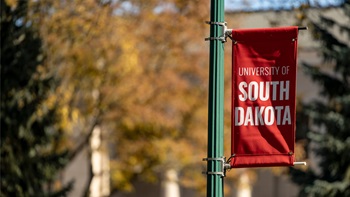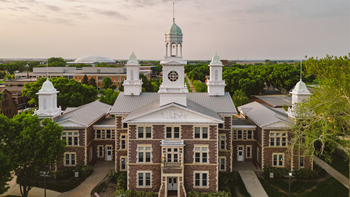A Mother's Love

Inès White and her family. Standing, left to right, is oldest daughter, Allie Riddle, daughter Katie and son Sam. Seated, from left to right are Allie’s daughter, Emma, Inès, Allie’s son, Wyatt and Inès’ husband, Chris.
Sam, their only son, was born in 1992. At age two, he started showing signs of developmental challenges. White suspected a hearing problem, and a local physician agreed. But White’s sister-in-law had familiarity with autism and suggested testing for the disorder. The confirmed diagnosis was known as Aspergers syndrome at the time, a condition within the autism spectrum disorder (ASD).
Despite his challenges, Sam graduated from high school with an impressive 3.6 GPA. “His resilience and intelligence shone through,” White explained. “He has a photographic memory.”
The White’s third child, Katie, is six years younger than Sam. As a little girl she demonstrated physical characteristics that initially stumped doctors, and her family subsequently embarked on a 16-year search for answers. Katie, too, showed autistic tendencies and faced difficulties with growth and development. It wasn’t until the family lived to St. Louis, Missouri, that a physician diagnosed her with Myhre syndrome, a rare genetic disorder with only 200 documented cases worldwide. Today, Katie is the only person in South Dakota with this condition. Myhre syndrome is life-threatening and can cause stiffening and thickening of organs and muscles in the body.
After learning about her daughter’s rare condition, White became part of the tight-knit Myhre syndrome community, and soon after its inception, in 2019, she became a board member of the Myhre Syndrome Foundation. “We’re all there for each other,” White explained. “Sadly, we have lost members of our small community. It’s devastating to all of us when this happens, which is why we are so determined to find a path to treatments.”
White’s resolve to provide her children with as many everyday life experiences as possible became her guiding light.
Sam has forged meaningful connections and friendships in the Vermillion community with his gregarious and affectionate personality. He works in the food service industry at the University of South Dakota and maintains his health through long walks.
Katie confronted different obstacles due to Myhre syndrome, including struggling with mobility issues and the constant risk of weight gain. The family installed a backyard swimming pool, where Katie has dedicated herself to regular exercise. “She’s working hard on weight management, better nutrition and her heart is good right now,” White explained.
Inès White’s personal journey and how it led her back to Vermillion is an integral part of this story. Her mother was a young woman living in Belgium when she watched a touring rodeo from the United States. Included in the rodeo troupe was a distinguished Native American from South Dakota named David Beautiful Bald Eagle. In addition to competing in the rodeo, Bald Eagle performed traditional Sioux dances. White’s mother and Bald Eagle met and eventually married. When White was seven years old, she and her family moved from Europe to Eagle Butte, South Dakota.
After graduating from high school, White enrolled at USD, where she participated in cross country, track and field, and Reserve Officers’ Training Corps (ROTC). She became the first member of her family to graduate from college. Following a long military career, White now works for a leading consulting organization providing high-level scientific, technical and analytic expertise to the U.S. government and military. In 2020, White was the commencement speaker at USD’s fall graduation.
The family resided in communities around the country and the world and could have chosen to live anywhere before they decided to return to Vermillion, the place Inès has long called her hometown. Vermillion is not only where White earned her college degree, it is where she met her husband. Returning to Vermillion, White explained, proved to be an ideal choice.
“Vermillion is a perfect place for my children,” declared White, who works remotely and travels the globe to fulfill defense institution-building assignments. “The Vermillion community is safe and friendly, and the people here have been remarkably supportive.
“Sam loves everyone in Vermillion, and everyone loves Sam,” continued White. “Katie is less social than Sam,” White explained, “but she has figured out how to co-exist with her syndrome. She is very aware of Myhre, and her threshold for pain is amazing. Although she doesn’t show much emotion, she pays close attention to how I become emotional over her.”
Katie has chosen to speak to groups about her disease, serving on panels, answering questions and raising awareness.
White has a special fondness for the Myhre Syndrome Foundation and the organization’s objectives, including connecting families and informing the public about Myhre syndrome. “I have come to understand how difficult it is for people and families, including me, to deal with their children who have the syndrome,” she acknowledged. “I have learned that because Myhre is so rare and complicated, the medical community has limited knowledge regarding how to help Katie. Teaching people about the disease is something I am passionate about.”
Despite the demands of an international job and supporting her family, White is dedicated to helping others who face the challenges of children with complex needs. “It’s not always easy fighting for a cause, but I want to be active, give back, and make a difference. I feel like it’s who I am.”
“My children are brave and resilient,” White declared. “I love and admire them; they have taught me so much. I’m a better person and mother because of what we’ve all been through together.”
To learn more about Myhre syndrome, visit myhresyndrome.org.
This story was originally published in “South Dakota Possibilities 2023,” an annual publication by the University of South Dakota Center for Disabilities. Access the full issue at this link.
About the Center for Disabilities
The Center for Disabilities is part of a national network of federally designated centers known as University Centers for Excellence in Development Disabilities, Education, Research and Service (UCEDDS). The mission of the Center for Disabilities is to improve the lives of individuals with disabilities and their families across the state of South Dakota, the region and nationally. The Center for Disabilities carries out its diverse capacity-building efforts through clinical services, interdisciplinary training, continuing education, research, information dissemination and policy/advocacy work. Its work focuses on the strengths and contributions of people with disabilities, and works across multiple sectors including healthcare, education, mental health, and human services.



